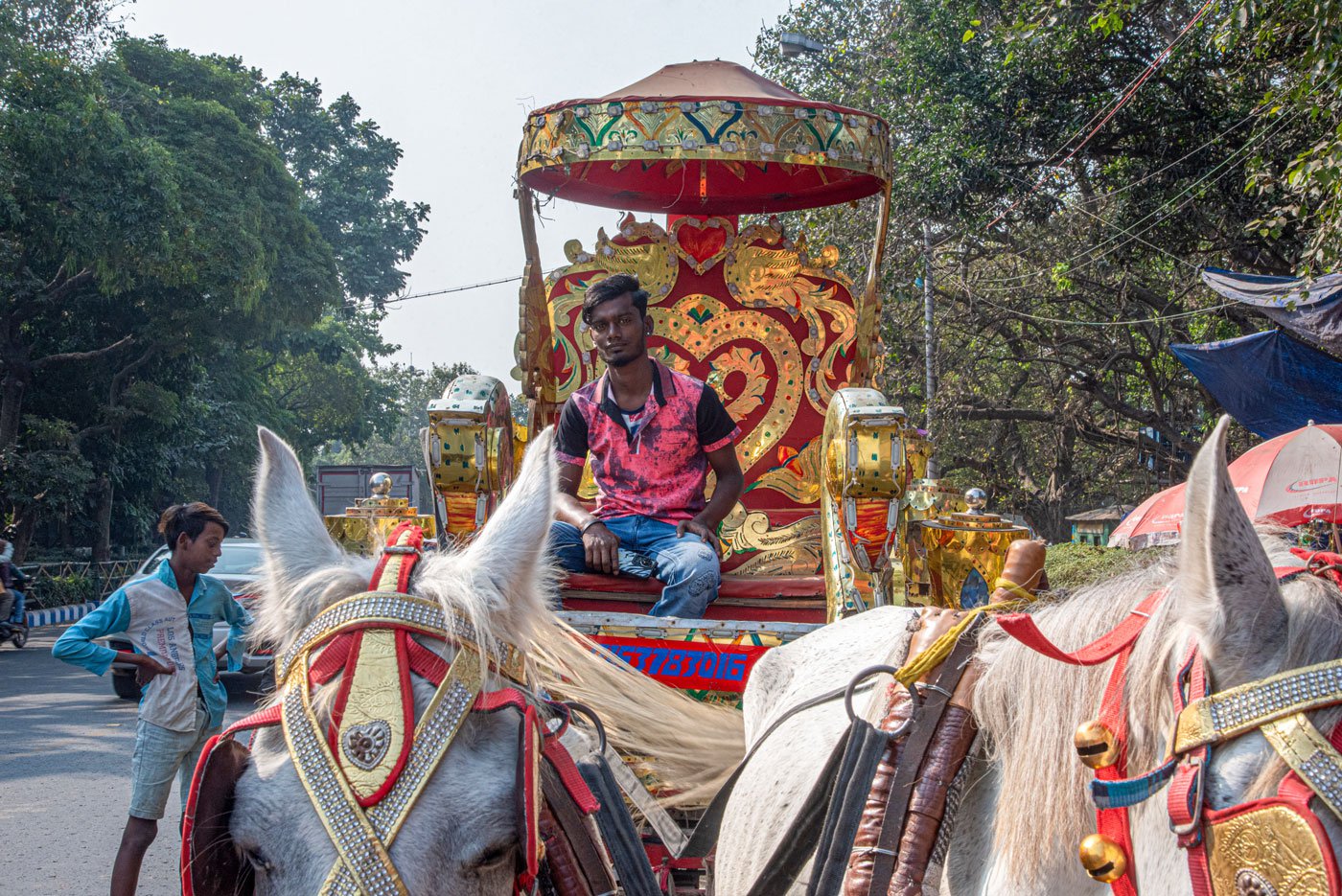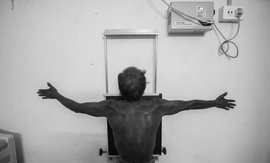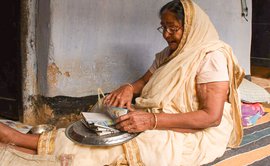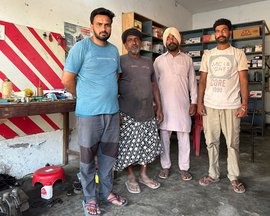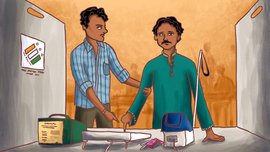Every morning Akif S.K. leaves his home in a makeshift jhupri (shack) under a bridge in Hastings and makes his way to the Victoria Memorial, a popular tourist attraction in Kolkata.
Enroute he picks up Rani and Bijli – the two white horses named by him, are the means to his seasonal livelihood. “ Ami gari chalai [I drive a carriage],” Akif says. He stables his animals near Hastings, picks them up around 10 a.m. and brings them to Victoria – the local name for the area around the marble edifice and open grounds in central Kolkata. The memorial to British monarch, Queen Victoria, was thrown open to the public in 1921.
Akif ’s carriage, which he rents everyday, is parked on the stretch known as Queen’s Way at Victoria Memorial. Pointing out his carriage from the line-up of around 10, he says, “mine is the golden one.” It’s another matter that most carriages here have the same colour scheme and elaborate floral patterns and bird motifs, and look like royal chariots. But Akif’s gleaming carriage does stand out he spends about two hours every day cleaning and polishing it for those seeking a touch of British Raj life.
Across the street, a small crowd has already gathered at the gates of Victoria Memorial. “In the old days, kings used to live here and they would ride around on carriages. Now visitors to Victoria come out and want to get a feel of that,” says the carriage driver who began doing this work in 2017. He goes on to add, “for as long as Victoria [Memorial] is there, the horse-carriages will be here as well.” And so will the job of the carriage drivers like him. There are about 50 carriages currently operating in this area.


Left: Akif’s helper for the day, Sahil, feeding the horses. Right: Rani and Bijli have been named by Akif and pull his carriage
Winter is here and as Kolkata warms up to spending the day outdoors, Akif get busy, especially in the evenings. He says the season lasts from November to February after which it gets too hot and few people come for rides in the open. We are sitting near the many snack and tea stalls that line the footpath opposite the memorial where tourists and carriage drivers can grab a quick bite.
Rani and Bijli are standing a little way away from us, occasionally shaking their manes while they munch on their breakfast of gom-er bhushi [wheat husk], bichali , dana [grains] and ghash [grass]. They will get to work soon, once they have had their fill and the modern-day chariot is ready. Feeding and cleaning their horses is key to the carriage drivers' livelihood. “It costs 500 rupees per day to take care of one horse,” Akif says. Besides grain and grass, they are also fed bichali (rice-straw) and he gets it from a shop in Watgunge near Kidderpore.
His own food comes in the afternoon, cooked and packed by his elder sister.
When we meet Akif in the morning, the rush is yet to begin. Occasionally, a group of tourists walk up to the carriages and are immediately surrounded by various drivers hoping to get the first ride of the day.


Left: Akif waiting for his coffee in front of one of many such stalls that line the footpath opposite Victoria Memorial. Right: A carriage waits
“On a good day, I get about three to four rides,” says Akif, who works till 9 p.m. The ride lasts for about 10 to 15 minutes, starting at the gates of Victoria Memorial, crossing the Race Course, before taking the turn from the south gate of Fort William. For each ride, the drivers here charge Rs. 500.
“For every 100 [rupees], I earn 25,” says Akif. The rest goes to the owner. On a good day, the carriage rides will fetch something between Rs. 2,000–3,000.
But there are other ways to earn from this l. It helps when “carriages are hired by wedding parties,” he adds. The cost for a carriage for the groom depends on how far the venue is. Within the city, the cost is something between 5,000-6,000 rupees.
“Our job is to take the groom to the venue. Once he reaches, we come back with the horse and carriage,” Akif says. Sometimes, they will travel outside Kolkata as well and so Akif has been to Medinipur and Kharagpur with his horse-drawn carriage. “I drove on the highway for two–three hours at a stretch,” he says, “and rested when required.” At night, he would stop next to the highway, untie the horses and sleep in the carriage.
“Carriages are hired for film shoots also,” Akif says. A few years ago, he had gone to the town of Bolpur for a shoot for a Bengali TV serial, covering a distance of about 160 kilometers. But weddings and shoots are not regular sources of income and he must find other means of earning when work here is scarce.


Left: 'It costs 500 rupees a day to take care of one horse,' Akif says. Right: Feeding and caring for the horses is key to his livelihood

Akif cleans and polishes the carriage after he arrives. He charges Rs. 500 for a single ride
Akif has been working with these two horses since October 2023. “When I started in this line, I would work part-time with horses owned by by brother-in-law [ married to his sister],” says the 22-year-old. For a while, Akif worked under someone else, and now, he is back working with the carriages owned by his sister's family.
For many of the workers here, including Akif, driving the carriage or taking care of the horses is not a full-time occupation.
“I am trained in painting houses and I also work at a friend’s garment shop in Burrabazar,” Akif says and adds, “my father was a rong-mistiri [labourer painting houses and buildings]. He came to Kolkata in 1998, before I was born.” Back in Barasat, where they lived, his father was a vegetable-seller. His parents moved to the big city where Akif’s aunt lived after getting married in order to earn a better living. “My aunt raised me because she didn’t have sons of her own,” Akif says. His father Alauddin Shaikh and mother Saeeda have moved back to their ancestral home in Barasat in the North 24 Parganas where Alauddin runs a small store selling cosmetic goods.
Akif now lives alone; his younger brother stays with their sister and occasionally drives the carriages owned by her in-laws.


'In the old days, kings used to live here and they would ride around on carriages. Now visitors to Victoria come out and want to get a feel of that,' Akif says
Scarcity of work is not the only problem carriage drivers face. He gets asked to tip the law: “I have to pay about 50 rupees daily,” Akif says. When we ask him if he has heard about the petition filed by People for the Ethical Treatment of Animals to ban horse-driven carriages, he responds saying, “every month there’s someone or the other who comes and tells us off for using the horses. ‘Why don’t you buy all the carriages and give us the money?’ we ask them. These horses are our livelihood.”
PETA’s petition also calls for electric carriages to replace the horse-drawn ones. “How can you call it a
ghorar gari
[horse-drawn carriage] if there are no horses?” the young carriage driver smiles and asks.
“There are some people who don’t look after their horses,” Akif admits. “But I do. You can tell they are well-treated just by looking at them!”
